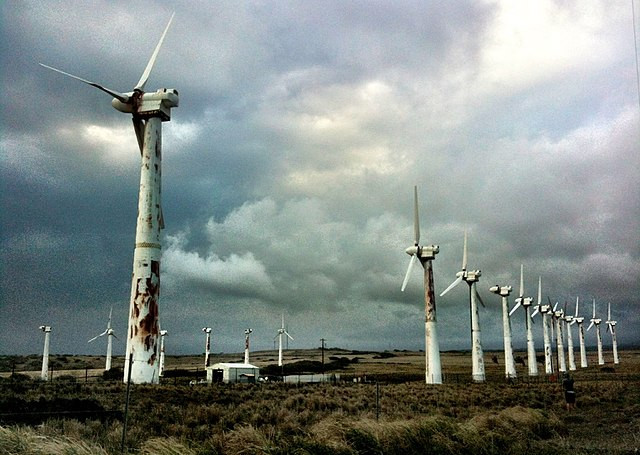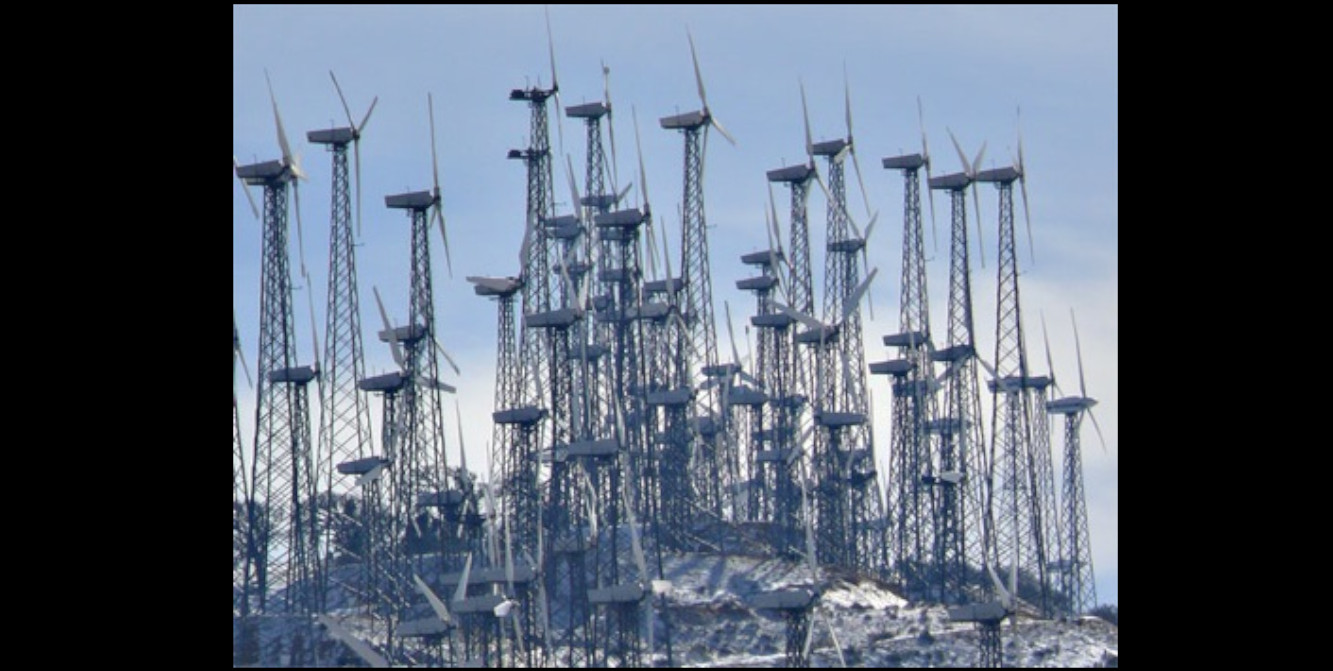Three words that are becoming more relevant as the promoters of Net Zero and the Green Initiative are forced to face the reality of transitioning to so-called renewable energies.
The image above is of a Californian wind farm (Tehachapi) which comprises hundreds of dead turbines, the result of a scam that was hastily put together in the late 1980s. And there are many more recent wind farms that have been abandoned because of costs and a lack of maintenance too.
The cost of building and maintaining wind-farms is astronomical and the effect on the environment is devastating. Consider this…
Electricity generated by wind farms is transported from remote locations to cities through a combination of high-voltage power lines and electrical grids.
Apart from the establishment of a site, site access and many large concrete pads to attach turbines to, wind farms also involve the installation of…
- Step-up Transformers:
Within the wind farm, the electricity produced by the wind turbines is initially at a relatively low voltage. Step-up transformers are used to increase the voltage to a higher level, typically in the range of thousands of volts, making it more suitable for long-distance transmission. - Transmission Lines:
High-voltage transmission lines, often referred to as power lines or grid infrastructure, are used to transport the electricity over long distances. These lines are designed to minimize energy losses during transmission. They can span hundreds or even thousands of kilometers, depending on the distance between the wind farm and the city. - Substations:
Along the transmission route, there are substations that serve as junction points for the electrical network. At these substations, the voltage is either stepped up further for long-distance transmission or stepped down for local distribution. - Grid Interconnection:
Wind farms are sometimes connected to the existing electrical grid before it reaches a city, which serves as an interconnected network to distribute and balance the supply and demand of electricity. This is not always possible though as existing lines may not be passing through the area. - Distribution Networks:
Once the electricity reaches urban areas, it enters the distribution network. Substations within the city step down the voltage to a level suitable for consumer use, typically 110V or 220V, and the electricity is then distributed through local power lines to homes, businesses, and other establishments.
The more wind farms there are, the more this process needs to be repeated and who pays for it all, the hapless taxpayer.
Copper
Without copper to transport the electricity the system simply wouldn’t work.
The majority of copper mine production comes from several countries around the world. Here are some of the largest copper-producing countries…
Chile:
Chile is the world’s largest producer of copper, accounting for a significant portion of global copper production. The country’s copper mines, such as the Chuquicamata and Escondida mines, are major contributors to its production.
Peru:
Peru is another significant producer of copper and ranks among the top copper-producing countries. The country’s mines, including the Antamina and Cerro Verde mines, contribute to its copper production.
China:
China is one of the largest consumers of copper, and it also has significant copper production. The country has both large-scale mines and smaller operations contributing to its copper output.
United States:
The United States has several copper-producing states, including Arizona, Utah, New Mexico, and Nevada. Copper mining operations in the United States, such as the Bingham Canyon Mine in Utah, contribute to the country’s overall copper production.
Australia:
Australia is a notable copper producer, with mining operations in regions like South Australia, Queensland, and Western Australia. The Olympic Dam mine in South Australia is a significant copper producer in the country.
Other countries with significant copper production include Russia, Zambia, Canada, Mexico, and Indonesia, among others.
What copper mining does to the environment
Copper mining, like any form of mining, can have seriously negative impacts on the environment. While it is essential to meet the global demand for copper, it is also important to acknowledge and address the potential environmental concerns associated with mining activities. Here are some environmental considerations related to copper mining…
Habitat Destruction:
Mining operations can result in the direct removal or alteration of natural habitats, including forests, grasslands, or wetlands, to access copper deposits. This can lead to the displacement or loss of plant and animal species.
Soil and Water Contamination:
Mining activities can release contaminants into the soil and water. Chemicals used in the extraction and processing of copper, such as sulfuric acid, can potentially contaminate water sources if not properly managed. Runoff from mining sites may carry heavy metals and other pollutants into nearby rivers, lakes, or groundwater.
Air Pollution:
Dust and emissions from mining operations, particularly during blasting, drilling, and transportation activities, can contribute to air pollution. These emissions may contain particulate matter, sulfur dioxide, nitrogen oxides, and other pollutants that can have adverse effects on air quality and human health.
Acid Mine Drainage:
In some cases, copper mining can result in the generation of acid mine drainage. This occurs when sulfide minerals present in the mined rock react with air and water, creating acidic conditions that can leach heavy metals and contaminate nearby water bodies.
Energy and Water Consumption:
Copper mining operations require significant amounts of energy and water. Extracting, processing, and transporting the ore involve energy-intensive processes, which can contribute to greenhouse gas emissions and increase water stress in water-scarce regions.
Land Disturbance and Reclamation:
Mining activities can lead to significant land disturbance, including the removal of vegetation, topsoil, and altering the landscape. Adequate reclamation and rehabilitation efforts are necessary to restore the land and minimize long-term environmental impacts.
Why wind turbines fail and are abandoned
Wind turbines can experience failures or malfunctions due to various factors. Here are some common causes:
- Mechanical Issues:
Mechanical failures can occur in components such as gearboxes, bearings, shafts, or generators. Over time, these components may wear out or develop faults due to stress, misalignment, or inadequate maintenance. Mechanical failures can lead to reduced efficiency, increased downtime, or complete turbine shutdown. - Electrical System Failures:
Electrical failures can occur in the turbine’s electrical systems, including the generator, power converter, or control systems. Issues such as short circuits, insulation breakdown, or faulty wiring can disrupt the electricity generation or transmission process. - Blade Damage:
Wind turbine blades are exposed to harsh weather conditions and stresses. Damage can occur due to impacts from debris, lightning strikes, or even material fatigue over time. Blade erosion caused by the environmental conditions can also reduce the turbine’s efficiency and lifespan. - Environmental Factors:
Extreme weather events, such as strong winds, storms, or icing conditions, can place significant stress on wind turbines. Turbines are designed to withstand these conditions, but severe weather events can lead to structural damage or component failures. - Maintenance and Operation:
Inadequate maintenance practices, including irregular inspections, insufficient lubrication, or delayed repairs, can increase the risk of failures. Operating the turbines outside their recommended parameters or ignoring warning signals can also contribute to failures. - Grid Integration Issues:
Challenges can arise during the integration of wind turbines into the electrical grid. Issues like voltage fluctuations, grid instability, or inadequate grid infrastructure can affect the performance and reliability of the turbines. - Human Error:
Errors in installation, operation, or maintenance processes can lead to failures. Improper assembly, incorrect adjustments, or neglecting safety procedures can all contribute to turbine malfunctions.
The typical operational lifespan of a wind turbine is generally considered to be just 20 to 25 years. However, this can depend on various factors, including the specific turbine design, the quality of its components, the operating and maintenance practices, and the environmental conditions in which it operates. Very often this lifespan is not achieved.
If constant fails are occurring at a wind farm, then most likely, it will become impractical and too expensive to continue, replace, or even demolish it. The result is a collection of abandoned towers littering the countryside. Monuments to the misguided Net Zero, renewable energy, religion.
